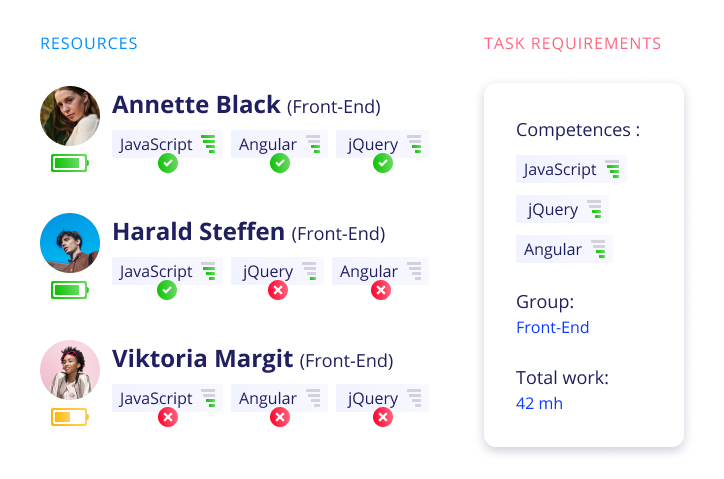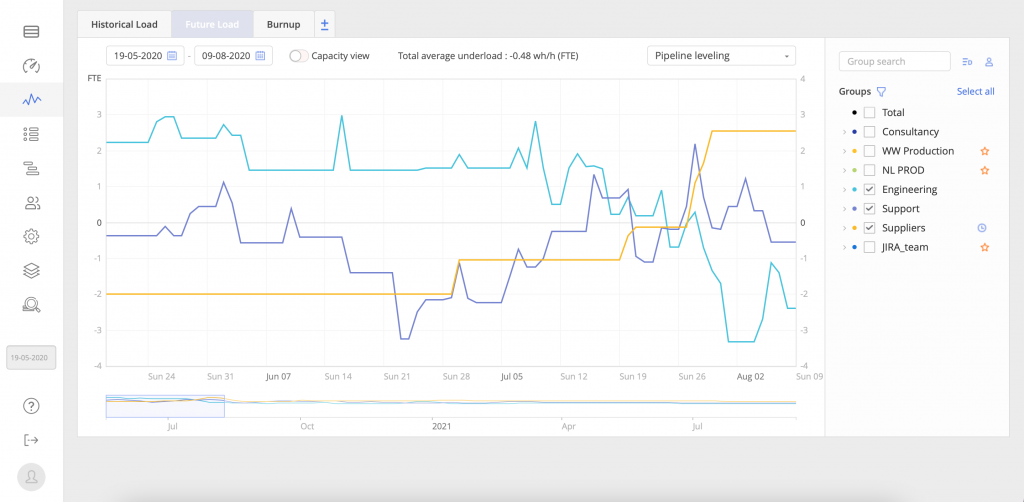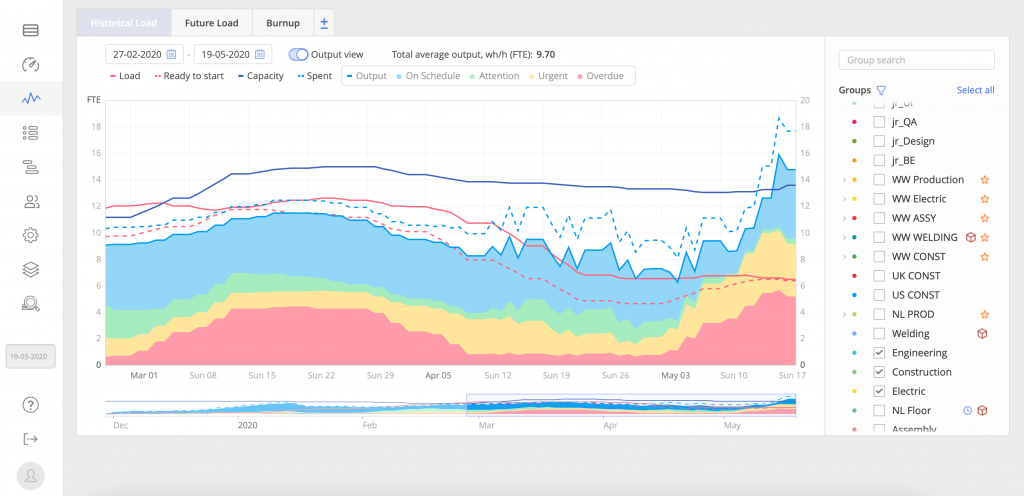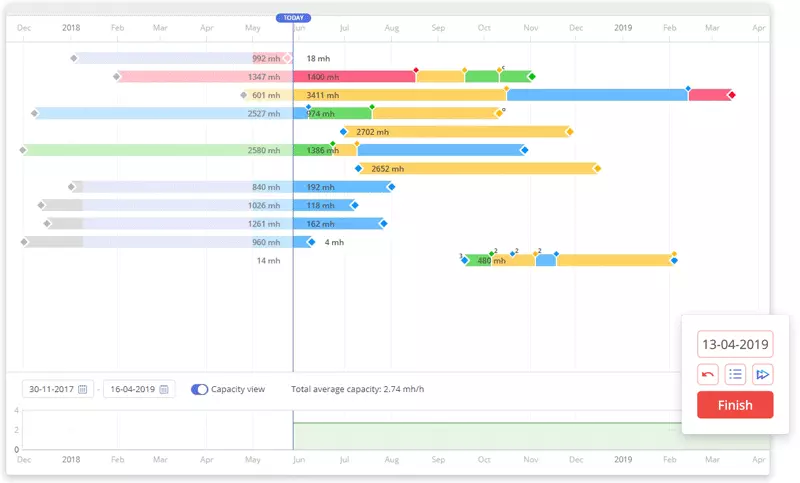Efficient resource management in a multi-project environment can be really demanding. You have to distribute resources effectively and at the same time weave in and out of numerous challenges – e.g., resource conflicts, managing globally distributed teams, uncertainty, and more. However, the right resource management strategies combined with the potential of software solutions can change the situation and make the resource management process seamless and fruitful. Read further to find out resource management best practices that will help you allocate the right people to the right tasks at the right time.
Why Is Resource Management Important?
Here are the main benefits of the effective resource management process for the workflow and an organization in general.
- More efficient utilization of available resources.
Effective resource management aims to ensure fruitful work on projects even when the number of employees is limited. This makes it possible to deliver more with less and increase projects’ profitability.
- Balancing employees’ workload.
Resource management implies that employees are assigned to project tasks in such a way that they are capable of completing them timely and efficiently without being overloaded.
- Increasing team members’ productivity.
When people have a balanced workload (neither overloaded, nor idle) and work on the tasks that correspond to their competences, they are productive and engaged. They are less prone to making mistakes, and there’ll be less probability for delivery delays.
- Project cost optimization.
Employees’ productive work on project tasks minimizes delays which result in exceeding the budget. Also, in a number of cases, effective resource management can reduce costs. Thanks to the right distribution of employees between tasks, there can be no more demand for hiring additional resources.
- Improved project outcomes.
When all resources involved in a project are productive and utilized to the full, the probability of successful project completion is much higher.
Now, let’s look into the recommendations that will make your resource management process effective.
7 Tips to Make Resource Management Effective
1. Start with resource planning and data-driven resource allocation.
These fundamental steps will set the right direction for the whole resource management process. The aim of resource planning is to make sure that projects will be provided with enough resources who have necessary knowledge, skills, and experience. It’s important for preventing resources’ underutilization, overallocation, and minimizing resource conflicts.
Resource allocation is the other pillar for the efficient resource management process. Proper resource allocation ensures that employees are utilized to the full and at the same time have balanced workload. Be guided by the following rules when distributing people between project tasks:
- allocate people to tasks according to their priorities: this will ensure timely completion of tasks;
- take into account employees’ skills, capacity, and availability: this will increase their productivity and minimize the probability of roadblocks in the workflow.
2. Plan for uncertainty
There may be plenty of reasons why something can go not the way it’s been planned. Companies dealing with large projects or a multi-project environment where a lot of human and material resources are involved usually face lots of uncertainty, i.e. lack of necessary information (you simply cannot allow for all the possibilities) and numerous external and internal events that can affect the workflow. It’s also known as Murphy’s Law that runs “If anything can go wrong, it will”, but you can’t know beforehand what can go wrong and why. So the main idea here is that you can’t avoid this uncertainty, but you can be prepared for it. How to do that?
- Set priorities between assignments, avoid setting strict task deadlines, and ask team members to complete them as soon as possible. This will prevent employees from falling into a trap of bad multitasking, student syndrome, or Parkinson’s law.
- If you have to make a decision under conditions of uncertainty, it’s a good idea to perform scenario analysis to predict probable outcomes depending on current actions or conditions. It can be performed during brainstorming sessions or by means of running simulations with project/resource management tools.
- Monitor your employees’ performance: knowing how they coped with their tasks in the past will give you an idea of what to expect of them in the future.
3. Apply resource optimization techniques
These techniques are applied when it becomes necessary to optimize resource utilization under conditions of resource and time constraints.
Resource leveling
According to PMBOK Guide, resource leveling is “a technique in which start and finish dates are adjusted based on resource constraints with the goal of balancing demand for resources with the available supply.” In simple words, when available resources are limited, you can adjust the project timeline in accordance with the availability of a critical employee. This technique prevents people from overallocation and is applied when there’s a resource constraint.
Resource smoothing
This technique is used when resources are allocated unevenly. In this case, the critical path cannot be changed as opposed to resource leveling; and it’s the time constraint that matters most here. Resource smoothing involves adjusting the project activities in such a way that the demand for resources on a project will not exceed the resource supply defined before. Usually, this technique is used after resource leveling.
4. Take care of resources’ workload
Keeping control of resources’ workload aims to ensure that resource capacity corresponds to resource demand and take necessary measures if it doesn’t. Improper workload (overload and idleness) is harmful for a project environment. As a result of overload, employees can become exhausted, disengaged, not committed to the work they are doing, have problems with physical and mental health, etc. They make mistakes and become a roadblock for the whole workflow. In turn, when some team members are overloaded and others are idle, it prevents an organization from intaking more projects and hampers its growth. So, it’s important to keep the workload balanced to ensure employees’ effective contribution to the project outcomes.
5. Manage employees’ competences
To ensure proper resource allocation, you need the information on all the team members’ competence levels. Also, competence management helps identify employees’ skill gaps and facilitate their professional development so that a resource manager can be more flexible when there is a lack of resources. Employees with a wide range of skills can replace each other if necessary; such teams are a valuable asset in the present-day dynamic business environment: thanks to being interchangeable, members of such teams can deliver the work faster.
6. Keep team members engaged
Employee engagement plays an important role in the quality of work they deliver. It’s supported by:
- motivation (providing the team members with constructive feedback, acknowledging their contribution to the project, supporting their initiatives);
- giving them room for errors (employees who are afraid of making mistakes are usually lacking initiative);
- empowering them to make decisions (delegating responsibility can improve team members’ efficiency).
7. Leverage resource management software
Currently, there are a variety of resource management tools that can assist resource managers in their work. Let’s consider Epicflow as an example – it’s a multi-project resource management solution focused on maximizing the efficiency of the workflow and resource utilization. Let’s take a closer look at its RM functionality.
-
Competence management: Optimized resource allocation
In Epicflow, you can easily keep track of employees’ competences. You can add as many of them as you need, specify their levels, and associate them with resources and tasks in the system. So, in a few clicks you’ll be able to find a perfect candidate for completing a task. In addition, Epicflow has a resource allocation advisor that suggests the best possible variants of assigning people to tasks based on their skills, capacity, and availability.
Read more: Epicflow Updates: Competence Management, Multigroups, Unit Pool, and More
-
Future Load Graph: Predicting bottlenecks
Epicflow is capable of predicting resources’ workload and output they are likely to produce. It allows a resource manager to avoid bottlenecks related to resource availability, prevent employees from overload, and optimize their utilization (e.g. if a group is expected to be idle in the future, its members can be assigned to other projects/tasks that require resources with similar competences).
-
Historical Load Graph: Getting insight into resource performance
This feature helps monitor and analyze resources’ performance. It consists of three elements: capacity, load, and output, and shows how they changed over time. Analysis of such information is essential for resource allocation, understanding how your team can perform in the future, or drawing conclusions as to the resource management process in dynamics.
-
What-if Analysis: Informed decision-making
What-if Analysis is your assistant in making informed decisions under conditions of uncertainty. For example, you can see how the workflow will change if tasks are assigned to certain team members, if the critical employee becomes unavailable, if you apply the resource leveling technique and shift a project’s due date, etc. With What-If Analysis, you can consider all possible alternatives, which will make it much easier to come up with the right decision.
-
Integration with human resource management systems
It provides updates on resources’ availability. Days off, vacations, and sick leaves marked in the human resource management system are imported into Epicflow, and employees’ availability is adjusted accordingly.
These were some examples of Epicflow’s features that contribute to maximum efficient utilization of project resources. Learn more about its resource management potential by booking a call with our expert.







first of all i thank you for this tip but i need more document about resource management